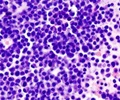New diagnostic tools such as RNA epigenetics and chromatin structures have the potential to reduce drug resistance in myelodysplastic syndrome (MDS) and acute myeloid leukemia (AML) patients.

‘Modern molecular and imaging technologies help better predict and provide more effective treatment for cancer and leukemia patients.’





Unfortunately, most patients treated with epigenetic modifying drugs develop resistance, resulting in therapeutic failure and eventually, patient death. The mechanisms underlying the selectivity and resistance of epigenetic modifying drugs remain largely elusive.A research team based at the University of Chicago has begun to unravel the role of RNA epigenetics and chromatin structure in regulation of 5-azacytidine (5-AZA), a well-known DNA hypomethylating agent in MDS and AML.
The finding may lead to novel strategies, as well as guidance from clinical biomarkers that could help predict and reduce the risk of drug resistance, a major obstacle in leukemia treatment.
"This is the first study to demonstrate that RNA cytosine methylation and methyltransferases mediate cell lineage-associated drug-responsive chromatin structures in MDS and AML," said the study's lead author, Jason Cheng, MD, PhD, assistant professor of pathology at the University of Chicago.
"This is a new area," he added. "Although a large number of RNA modifications have been identified in the past, the function and the clinical potential of those RNA modifications and their effects on gene regulation and chromatin organization remain largely unexplored."
Advertisement
In human cells, chromatin is organized into distinct structures with functional domains that regulate gene expression and stem cell development. Chemical modifications of histones, DNA and RNA can change chromatin structures.
Advertisement
The research team was particularly interested in the role of RNA:m5C and RCMTs in regulation of cell lineage-associated chromatin structures and drug response/resistance in MDS and AML. They found a significant increase in RNA:m5C and RCMTs in 5-AZA-resistant leukemia cells compared to that in 5-AZA-sensitive leukemia cells.
They show that 5-AZA-sensitive and 5-AZA-resistant leukemia cells have distinctly different chromatin structures that are associated with RNA:m5C and RCMTs at nascent RNA, as schematically illustrated.
Specifically, in 5-AZA-sensitive leukemia cells, RCMTs--namely NSUN3 and DNMT2--bind hnRNPK, a conserved RNA-binding protein, to recruit active RNA polymerase II (RNA-pol-II) to form an active chromatin structure at nascent RNA.
In contrast, a different RCMT, called NSUN1, interacts with BRD4, a histone modifier, to recruit RNA-pol-II to form a different active chromatin structure at nascent 5-AZA-resistant leukemia cells. This NSUN1/BRD4-mediated chromatin structure renders these leukemia cells insensitive to 5-AZA, but hypersensitive to the BRD4 inhibitor, JQ1, and to the downregulation of NSUN1 by siRNAs.
By applying new technologies--including mass spectrometric analysis and proximity ligation rolling circle amplification confocal microscopy--to a small size of clinical MDS/AML specimens (n=18), the researchers demonstrated a significant increase in RNA:m5C and RCMTs and the NSUN1/BRD4-associated chromatin structure in 5-AZA-resistant vs. 5-AZA-sensitive clinical MDS/AML specimens.
"With the advent of modern molecular and imaging technologies, functional genomics will become a central platform to elucidate the function of genes, signal pathways and genetic networks, to determine the pathogenetic roles of gene mutations and provide powerful tools for better prognosis and more effective treatment for cancer/leukemia patients," Cheng said.
"We are moving towards functional genomics through exploring the potential of using RNA epigenetics and chromatin structures as diagnostic tools and potential therapeutic targets in MDS/AML patients," he added.
Additional studies are needed to identify the genetic alterations underlying the RNA epigenetics-mediated drug-responsive chromatin structures in MDS and AML. A large clinical study is necessary to determine the full potential and the limitation of such RNA epigenetics and chromatin structure-driven strategies in the future.
Source-Eurekalert














